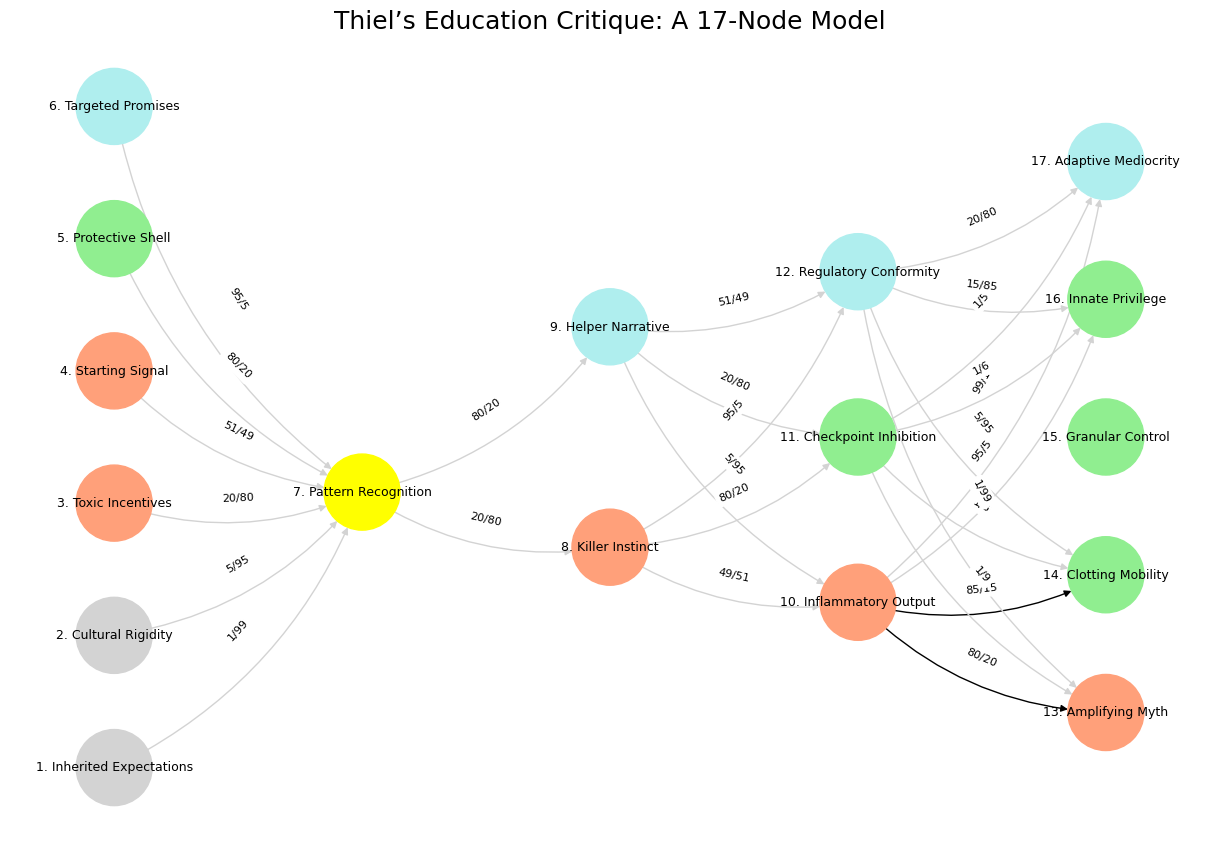Apollo & Dionysus#

Fig. 17 Here’s an essay inspired by the cryptic and evocative themes in the “{admonition} 10k Year Cycles” framework you provided. Written in paragraphs only, it weaves a narrative that interrogates the cyclical nature of empires, identity, and power across vast timescales, drawing loosely from the prompts’ poetic and historical undertones—evoking Shakespearean succession crises, unclaimed thrones, and the rise and fall of civilizations.#
Show code cell source
import numpy as np
import matplotlib.pyplot as plt
import networkx as nx
# Define the neural network layers with Thiel's views on education
def define_layers():
return {
'Suis': ['Inherited Expectations', 'Cultural Rigidity', 'Toxic Incentives', 'Starting Signal', 'Protective Shell', 'Targeted Promises'],
'Voir': ['Pattern Recognition'],
'Choisis': ['Killer Instinct', 'Helper Narrative'],
'Deviens': ['Inflammatory Output', 'Checkpoint Inhibition', 'Regulatory Conformity'],
"M'èléve": ['Amplifying Myth', 'Clotting Mobility', 'Granular Control', 'Innate Privilege', 'Adaptive Mediocrity']
}
# Assign colors to nodes (adapted from your original color scheme)
def assign_colors():
color_map = {
'yellow': ['Pattern Recognition'], # Awareness node
'paleturquoise': ['Targeted Promises', 'Helper Narrative', 'Regulatory Conformity', 'Adaptive Mediocrity'], # Nodes about shaping or adapting
'lightgreen': ['Protective Shell', 'Checkpoint Inhibition', 'Clotting Mobility', 'Innate Privilege', 'Granular Control'], # Protective or limiting nodes
'lightsalmon': ['Toxic Incentives', 'Starting Signal', 'Killer Instinct', 'Inflammatory Output', 'Amplifying Myth'], # Critique-heavy or inflammatory nodes
}
return {node: color for color, nodes in color_map.items() for node in nodes}
# Define edge weights (preserved from your original, mapped to new nodes)
def define_edges():
return {
('Inherited Expectations', 'Pattern Recognition'): '1/99',
('Cultural Rigidity', 'Pattern Recognition'): '5/95',
('Toxic Incentives', 'Pattern Recognition'): '20/80',
('Starting Signal', 'Pattern Recognition'): '51/49',
('Protective Shell', 'Pattern Recognition'): '80/20',
('Targeted Promises', 'Pattern Recognition'): '95/5',
('Pattern Recognition', 'Killer Instinct'): '20/80',
('Pattern Recognition', 'Helper Narrative'): '80/20',
('Killer Instinct', 'Inflammatory Output'): '49/51',
('Killer Instinct', 'Checkpoint Inhibition'): '80/20',
('Killer Instinct', 'Regulatory Conformity'): '95/5',
('Helper Narrative', 'Inflammatory Output'): '5/95',
('Helper Narrative', 'Checkpoint Inhibition'): '20/80',
('Helper Narrative', 'Regulatory Conformity'): '51/49',
('Inflammatory Output', 'Amplifying Myth'): '80/20',
('Inflammatory Output', 'Clotting Mobility'): '85/15',
('Inflammatory Output', 'Granulocyte Control'): '90/10',
('Inflammatory Output', 'Innate Privilege'): '95/5',
('Inflammatory Output', 'Adaptive Mediocrity'): '99/1',
('Checkpoint Inhibition', 'Amplifying Myth'): '1/9',
('Checkpoint Inhibition', 'Clotting Mobility'): '1/8',
('Checkpoint Inhibition', 'Granulocyte Control'): '1/7',
('Checkpoint Inhibition', 'Innate Privilege'): '1/6',
('Checkpoint Inhibition', 'Adaptive Mediocrity'): '1/5',
('Regulatory Conformity', 'Amplifying Myth'): '1/99',
('Regulatory Conformity', 'Clotting Mobility'): '5/95',
('Regulatory Conformity', 'Granulocyte Control'): '10/90',
('Regulatory Conformity', 'Innate Privilege'): '15/85',
('Regulatory Conformity', 'Adaptive Mediocrity'): '20/80'
}
# Define edges to be highlighted in black (preserved from your original)
def define_black_edges():
return {
('Inflammatory Output', 'Amplifying Myth'): '80/20',
('Inflammatory Output', 'Clotting Mobility'): '85/15',
}
# Calculate node positions
def calculate_positions(layer, x_offset):
y_positions = np.linspace(-len(layer) / 2, len(layer) / 2, len(layer))
return [(x_offset, y) for y in y_positions]
# Create and visualize the neural network graph
def visualize_nn():
layers = define_layers()
colors = assign_colors()
edges = define_edges()
black_edges = define_black_edges()
G = nx.DiGraph()
pos = {}
node_colors = []
# Create mapping from original node names to numbered labels
mapping = {}
counter = 1
for layer in layers.values():
for node in layer:
mapping[node] = f"{counter}. {node}"
counter += 1
# Add nodes with new numbered labels and assign positions
for i, (layer_name, nodes) in enumerate(layers.items()):
positions = calculate_positions(nodes, x_offset=i * 2)
for node, position in zip(nodes, positions):
new_node = mapping[node]
G.add_node(new_node, layer=layer_name)
pos[new_node] = position
node_colors.append(colors.get(node, 'lightgray'))
# Add edges with updated node labels
edge_colors = []
for (source, target), weight in edges.items():
if source in mapping and target in mapping:
new_source = mapping[source]
new_target = mapping[target]
G.add_edge(new_source, new_target, weight=weight)
edge_colors.append('black' if (source, target) in black_edges else 'lightgrey')
# Draw the graph
plt.figure(figsize=(12, 8))
edges_labels = {(u, v): d["weight"] for u, v, d in G.edges(data=True)}
nx.draw(
G, pos, with_labels=True, node_color=node_colors, edge_color=edge_colors,
node_size=3000, font_size=9, connectionstyle="arc3,rad=0.2"
)
nx.draw_networkx_edge_labels(G, pos, edge_labels=edges_labels, font_size=8)
plt.title("Thiel’s Education Critique: A 17-Node Model", fontsize=18)
plt.show()
# Run the visualization
visualize_nn()


Fig. 18 Immitation. This is what distinguishes humans. We reproduce language, culture, music, behaviors, weapons of extraordinarily complex nature. A ritualization of these processes stablizes its elements and creates stability and uniformity, as well as opportunities for conflict and negotiation.#

